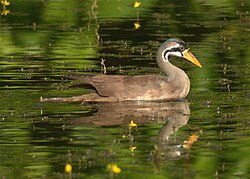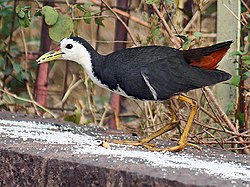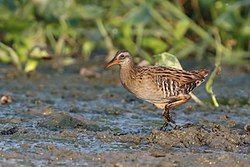| Common name | Binomial name | Population | Status | Trend | Notes | Image |
|---|
| Samoan moorhen (Samoan woodhen) | Gallinula pacifica | 0-49 [10] | CR [10] | ? [10] | May be extinct. Last confirmed record in 1873; recent surveys have returned no evidence of an extant population. [10] IUCN/BirdLife International place species in genus Pareudiastes. |  |
| Makira woodhen | Gallinula silvestris | 1-49 [11] | CR [11] | ? [11] | Last undisputed scientific observation occurred in 1953; however, unconfirmed sightings as recently as 2014 indicate the species persists in small numbers. [11] IUCN/BirdLife International place species in genus Pareudiastes. | |
| New Caledonian rail | Gallirallus lafresnayanus | 1-49 [12] | CR [12] | ? [12] | May be extinct. Last confirmed sighting in 1890, and no unconfirmed sightings since 1984. [12] | 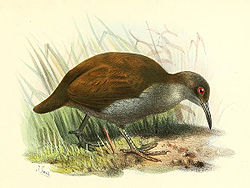 |
| Guam rail | Hypotaenidia owstoni | 1-49 [13] | CR [13] |  [13] [13] | Species was formerly extinct in the wild. A reintroduced population is now established on Cocos. [13] |  |
| Buff-breasted buttonquail | Turnix olivii | 1-249 [14] | CR [14] | ? [14] | May be extinct. Best estimate for number of mature individuals is 1-49. [14] |  |
| Zapata rail | Mustelirallus cerverai | 50-249 [15] | CR [15] |  [15] [15] | Total population is estimated to be 70-400 individuals. [15] IUCN/BirdLife International place species in genus Cyanolimnas. |  |
| White-winged flufftail | Sarothrura ayresi | 50-249 [16] | CR [16] |  [16] [16] | Best estimate for number of mature individuals is 226. [16] | 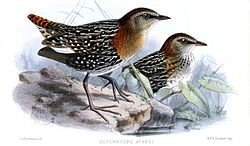 |
| South Island takahē (Takahē) | Porphyrio hochstetteri | 50-249 [17] | EN [17] |  [17] [17] | Total population is estimated to be 418 individuals. [17] |  |
| Whooping crane | Grus americana | 50-249 [18] | EN [18] |  [18] [18] | Total wild population is 483 individuals; the only self-sustaining breeding population contains 329 individuals, of whom less than 250 are mature. [18] |  |
| Masked finfoot | Heliopais personatus | 108-304 [19] | CR [19] |  [19] [19] | | |
| Lord Howe woodhen | Hypotaenidia sylvestris | 200-286 [20] | EN [20] |  [20] [20] | Endemic to Lord Howe Island. Best estimate for number of mature individuals is 230. [20] |  |
| Plain-flanked rail | Rallus wetmorei | 200-1,000 [21] | EN [21] |  [21] [21] | | |
| Sakalava rail | Zapornia olivieri | 250-999 [22] | EN [22] |  [22] [22] | |  |
| Slender-billed flufftail | Sarothrura watersi | 250-999 [23] | NT [23] |  [23] [23] | |  |
| Okinawa rail | Hypotaenidia okinawae | 480 [24] | EN [24] |  [24] [24] | Total population is estimated to be 720 individuals. [24] |  |
| Talaud rail | Gymnocrex talaudensis | 500-2,500 [25] | EN [25] |  [25] [25] | Best estimate for number of mature individuals is 500-1,000. [25] | |
| Chestnut-headed flufftail | Sarothrura lugens | 670-6,700 [26] | LC [26] |  [26] [26] | Total population is estimated to be 1,000-10,000 individuals. [26] | |
| Rusty-flanked crake | Laterallus levraudi | 1,000-2,499 [27] | VU [27] |  [27] [27] | Total population is estimated to be 1,500-3,750 individuals. [27] |  |
| Austral rail | Rallus antarcticus | 1,000-9,999 [28] | VU [28] |  [28] [28] | Best estimate for number of mature individuals is 2,500-9,999. [28] | 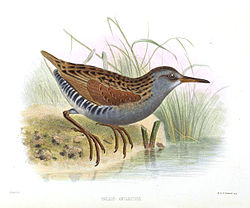 |
| Rufous-faced crake | Laterallus xenopterus | 1,000-10,000 [29] | VU [29] |  [29] [29] | | 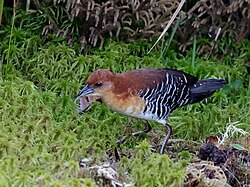 |
| Hawaiian coot | Fulica alai | 1,250-1,750 [30] | NT [30] |  [30] [30] | Total population is estimated to be, at minimum, 1,248– 2,577 individuals. [30] |  |
| New Britain rail (Pink-legged rail) | Hypotaenida insignis | 1,500-7,000 [31] | NT [31] |  [31] [31] | Total population is estimated to be 2,500-9,999 individuals. [31] | 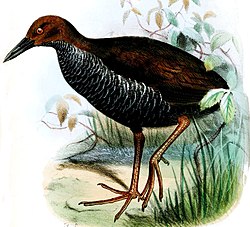 |
| Rouget's rail | Rougetius rougetii | 1,500-7,000 [32] | NT [32] |  [32] [32] | Total population is estimated to be 2,500-9,999 individuals. [32] | 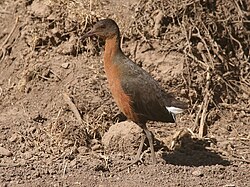 |
| Madagascar rail | Rallus madagascariensis | 1,600-6,700 [33] | VU [33] |  [33] [33] | Total population is estimated to be 2,500-10,000 individuals. [33] | 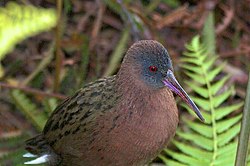 |
| Auckland Island rail (Auckland rail) | Lewinia muelleri | 2,000 [34] | VU [34] |  [34] [34] | |  |
| Red-crowned crane | Grus japonensis | 2,000-2,650 [35] | VU [35] |  [35] [35] | Best estimate for number of mature individuals is 2,300. [35] | 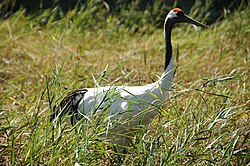 |
| Calayan rail | Aptenorallus calayanensis | 2,500-6,000 [36] | VU [36] |  [36] [36] | |  |
| Tsingy forest rail | Mentocrex beankaensis | 2,500-9,999 [37] | VU [37] |  [37] [37] | | |
| Roviana rail | Hypotaenida rovianae | 2,500-9,999 [38] | LC [38] |  [38] [38] | Population estimated is considered to be outdated. [38] | |
| Talaud bush-hen | Amaurornis magnirostris | 2,500-20,000 [39] | VU [39] |  [39] [39] | | |
| Black-breasted buttonquail | Turnix melanogaster | 3,000-6,500 [40] | VU [40] |  [40] [40] | Best estimate for number of mature individuals is 4,800. [40] | 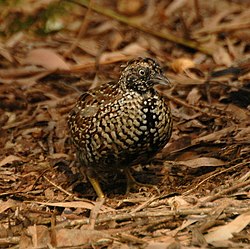 |
| Galapagos rail (Galapagos crake) | Laterallus spilonota | 3,300-6,700 [41] | VU [41] |  [41] [41] | Total population is estimated to be 5,000-10,000 individuals. [41] |  |
| Siberian crane | Leucogeranus leucogeranus | 3,500-4,000 [42] | CR [42] |  [42] [42] | Values given are for total population. [42] |  |
| Bogotá rail | Rallus semiplumbeus | 3,700 [43] | VU [43] |  [43] [43] | Total population is estimated to be 5,600 individuals. [43] | 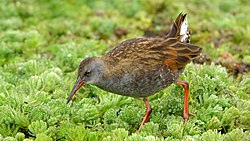 |
| White-naped crane | Antigone vipio | 3,700-4,500 [44] | VU [44] |  [44] [44] | Total population is estimated to be 6,250-6,750 individuals. [44] IUCN/BirdLife International place species in genus Grus. | 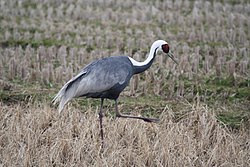 |
| Henderson Island crake (Red-eyed crake) | Zapornia atra | 3,800-8,400 [45] | VU [45] |  [45] [45] | Best estimate for number of mature individuals is 6,400 individuals. To population is estimated to be 8,513 individuals. [45] |  |
| Junin rail (Junin crake) | Laterallus tuerosi | 4,100 [46] | EN [46] |  [46] [46] | Note that IOC taxonomy treats this species as a subspecies of black rail (L. jamaicensis). [1] |  |
| Horned coot | Fulica cornuta | 5,000-25,000 [47] | NT [47] |  [47] [47] | |  |
| White-throated rail | Dryolimnas cuvieri | 5,099-7,499 [48] | LC [48] | ? [48] | Values are for total population. Likely a large underestimate, as numbers do not include an estimate for Madagascar, which composes the majority of the species' range. [48] |  |
| Inaccessible Island rail | Laterallus rogersi | 5,460-7,320 [49] | VU [49] |  [49] [49] | Best estimate for number of mature individuals is 6,180. Total population is estimated to be 9,100 - 12,200 individuals. [49] |  |
| Wattled crane | Grus carunculata | 6,000-6,300 [50] | VU [50] |  [50] [50] | Total population is estimated to be 9,000-10,000 individuals. [50] IUCN/BirdLife International give the binomial name Bugeranus carunculatus. |  |
| Black-necked crane | Grus nigricollis | 6,600-6,800 [51] | NT [51] |  [51] [51] | Total population is estimated to be 10,000-10,200 individuals. [51] |  |
| Andaman crake | Rallina canningi | 6,700-17,000 [52] | LC [52] |  [52] [52] | Total population is estimated to be 10,000-25,000 individuals. [52] |  |
| Yellow rail | Coturnicops noveboracensis | 6,700-17,000 [53] | LC [53] |  [53] [53] | Total population is estimated to be 10,000-25,000 individuals. [53] |  |
| Madagascar flufftail | Sarothrura insularis | 6,700-66,700 [54] | LC [54] | ? [54] | Total population is estimated to be 10,000-100,000 individuals. [54] |  |
| Spotted rail | Pardirallus maculatus | 7,000-18,000 [55] | LC [55] |  [55] [55] | Total population is estimated to be 11,000-26,700 individuals. Population may be larger than estimated. [55] |  |
| Yellow-breasted crake | Laterallus flaviventer | >7,000 [56] | LC [56] | ? [56] | |  |
| Dot-winged crake | Laterallus spilopterus | 8,000-19,999 [57] | NT [57] |  [57] [57] | |  |
| Gough Island moorhen (Gough moorhen) | Gallinula comeri | 8,500 [58] | VU [58] |  [58] [58] | Total population is estimated to be 13,000 individuals. Note that there are ~4,000 additional mature individuals on Tristan da Cunha, but they are introduced, and thus not counted in IUCN estimates. [58] |  |
| Hooded crane | Grus monacha | 9,750-13,000 [59] | VU [59] |  [59] [59] | Total population is estimated to be 15,000-18,000 individuals. [59] |  |
| Ridgway's rail | Rallus obsoletus | 10,000-19,999 [60] | NT [60] |  [60] [60] | |  |
| Slaty-breasted wood-rail | Aramides saracura | 10,000-25,000 [61] | LC [61] |  [61] [61] | |  |
| African crake | Crex egregia | 10,000-1,000,000 [62] | LC [62] | ? [62] | Values given are for total population, but estimate is considered to be outdated. [62] |  |
| Buff-banded rail | Hypotaenidia philippensis | 10,600-141,000 [63] | LC [63] |  [63] [63] | Total population is estimated to be 15,850-210,991 individuals. [63] |  |
| Blackish rail | Pardirallus nigricans | 13,300-73,300 [64] | LC [64] | ? [64] | Total population is estimated to be 20,000-110,000 individuals. [64] |  |
| Mexican rail (Aztec rail) | Rallus tenuirostris | 15,000 [65] | NT [65] |  [65] [65] | |  |
| Brown wood-rail | Aramides wolfi | >15,000 [66] | LC [66] |  [66] [66] | No formal estimates have been quantified. Values assume a very conservative species density from limited surveys. [66] |  |
| Sarus crane | Antigone antigone | 15,000-17,500 [67] | VU [67] |  [67] [67] | Best estimate for number of mature individuals is 16,000. [67] IUCN/BirdLife International still place species in genus Grus. | 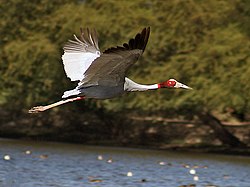 |
| Blue crane | Grus paradisea | 17,000-30,000 [68] | VU [68] |  [68] [68] | Total population is estimated to be 25,550-45,132 individuals. [68] IUCN/BirdLife International give the binomial name Anthropoides paradiseus. | 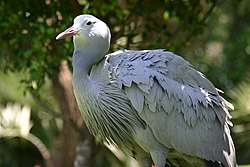 |
| Grey crowned crane | Balearica regulorum | 20,100-24,600 [69] | EN [69] |  [69] [69] | Total population is estimated to be 30,200-36,900 individuals. [69] |  |
| African finfoot | Podica senegalensis | 30,000-823,000 [70] | LC [70] | ? [70] | Total population is estimated to be 45,002-1,235,000 individuals. [70] | |
| Black crowned crane | Balearica pavonina | 44,000-74,000 [71] | VU [71] |  [71] [71] | Total population is estimated to be 66,000-111,000 individuals. [71] |  |
| Russet-naped wood-rail | Aramides albiventris | 50,000-499,999 [72] | LC [72] |  [72] [72] | |  |
| Rufous-necked wood-rail | Aramides axillaris | 50,000-499,999 [73] | LC [73] |  [73] [73] | |  |
| Uniform crake | Amaurolimnas concolor | 50,000-499,999 [74] | LC [74] |  [74] [74] | |  |
| Paint-billed crake | Mustelirallus erythrops | 50,000-499,999 [75] | LC [75] | ? [75] | IUCN/BirdLife International place species in genus Neocrex. |  |
| Ruddy crake | Laterallus ruber | 50,000-499,999 [76] | LC [76] |  [76] [76] | |  |
| Mangrove rail | Rallus longirostris | 50,000-500,000 [77] | LC [77] |  [77] [77] | |  |
| Ash-throated crake | Mustelirallus albicollis | 66,700-667,000 [78] | LC [78] |  [78] [78] | Total population is estimated to be 99,999-999,999 individuals. [78] IUCN/BirdLife International place species in genus Porzana. |  |
| Giant wood-rail | Aramides ypecaha | 66,700-667,000 [79] | LC [79] |  [79] [79] | Total population is estimated to be 100,000-1,000,000 individuals. [79] |  |
| King rail | Rallus elegans | 69,000 [80] | NT [80] |  [80] [80] | |  |
| Weka | Gallirallus australis | 71,000-118,000 [81] | VU [81] |  [81] [81] | Total population is estimated to be 107,000-177,000 individuals. [81] | 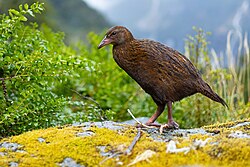 |
| Spot-flanked gallinule | Porphyriops melanops | 73,300-735,000 [82] | LC [82] |  [82] [82] | Total population is estimated to be 110,001-1,102,500 individuals. [82] |  |
| Virginia rail | Rallus limicola | 100,000-499,999 [83] | LC [83] |  [83] [83] | Best estimate for number of mature individuals is 240,000. [83] Note that IOC taxonomy splits an additional species, the Ecuadorian rail, from this species. [1] IUCN/BirdLife International maintain both species within R.limicola. [84] |  |
| Clapper rail | Rallus crepitans | 210,000 [85] | LC [86] |  [86] [86] | IUCN/BirdLife International do not report a population estimate, citing recent taxonomic splits. [86] Estimate is available through Partners in Flight. [85] |  |
| Demoiselle crane | Grus virgo | 230,000-261,000 [87] | LC [87] |  [87] [87] | Values given are for total population. [87] IUCN/BirdLife International place species in genus Anthropoides. |  |
| Common crane | Grus grus | 479,000-572,000 [88] | LC [88] |  [88] [88] | Total population is estimated to be 718,160-858,240 individuals. [88] |  |
| Sungrebe | Heliornis fulica | 500,000-4,999,999 [89] | LC [89] |  [89] [89] | |  |
| Western water rail (Water rail) | Rallus aquaticus | 628,000-1,300,000 [90] | LC [90] | ? [90] | |  |
| Red-gartered coot | Fulica armillata | 667,000 [91] | LC [91] | ? [91] | Total population is estimated to be 1.0 million individuals. [91] |  |
| White-winged coot | Fulica leucoptera | 667,000 [92] | LC [92] |  [92] [92] | Total population is estimated to be 1.0 million individuals. [92] | 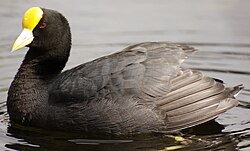 |
| Black crake | Zapornia flavirostra | 667,000 [93] | LC [93] |  [93] [93] | Total population is estimated to be 1.0 million individuals. [93] |  |
| Limpkin | Aramus guarauna | 672,000-687,000 [94] | LC [94] |  [94] [94] | Total population is estimated to be 1,008,749-1,029,799 individuals. [94] | 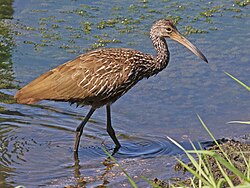 |
| Plumbeous rail | Pardirallus sanguinolentus | 683,000-1,340,000 [95] | LC [95] |  [95] [95] | Total population is estimated to be 1,024,998-2,009,998 individuals. [95] |  |
| Corncrake | Crex crex | 3,270,000-5,270,000 [96] | LC [96] |  [96] [96] | Total population is estimated to be 4.9-7.9 million individuals. [96] |  |
| Grey-cowled wood-rail | Aramides cajaneus | 5,000,000-50,000,000 [97] | LC [97] |  [97] [97] | |  |
| American coot | Fulica americana | 7,100,000 [98] | LC [98] |  [98] [98] | |  |
| Common moorhen | Gallinula chloropus | 9,069,000-13,527,000 [99] | LC [99] |  [99] [99] | |  |
|










